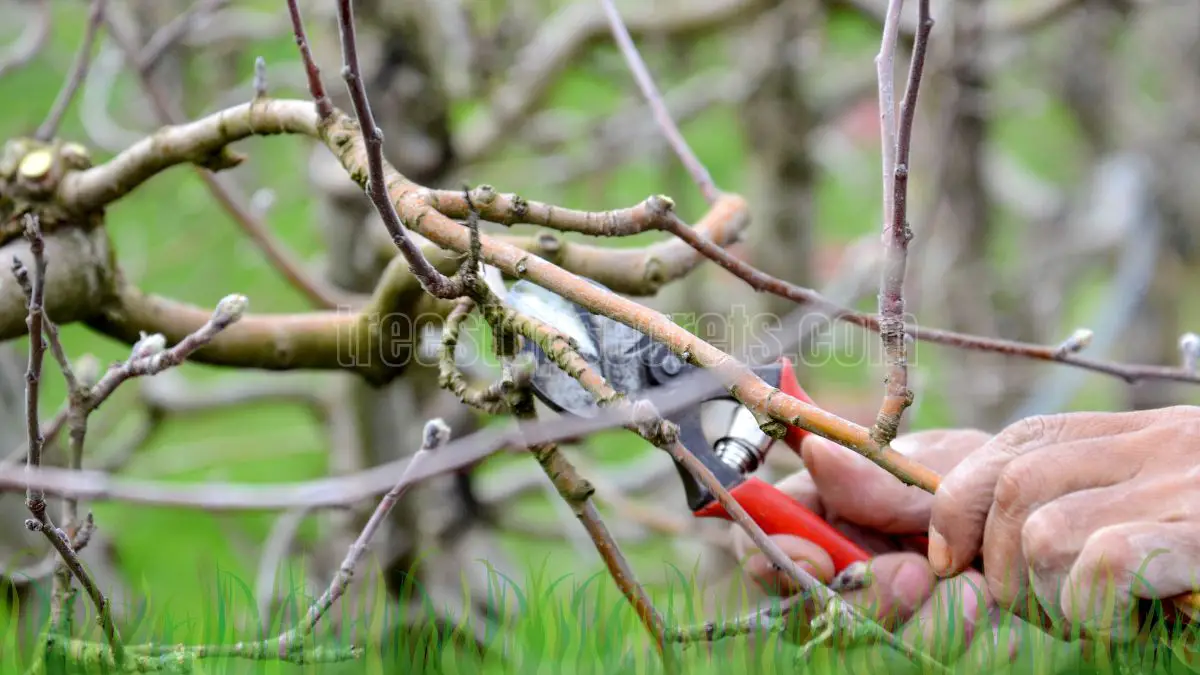Pruning your apple tree at the right time is key to promoting healthy growth and abundant fruit production. Whether you're a new gardener or an experienced one, knowing when to prune can make a big difference. In this guide, we’ll cover the ideal timing and methods for pruning apple trees to ensure they thrive throughout the seasons. Read on to learn how to boost your tree’s health and harvest!
Pruning an apple tree should be done during late winter or early spring, before the new growth begins. This timing allows the tree to heal faster and focus its energy on producing strong branches and healthy fruit. Late winter pruning also makes it easier to see the tree’s structure and remove any dead or overcrowded branches.
Wondering how pruning can help your apple tree flourish? If you want bigger, better apples, proper pruning is the key! Stick around for expert tips and practical advice on how to prune like a pro, ensuring your tree thrives year after year. Let’s get started on growing the perfect apple harvest!
The Best Time for Pruning apple tree
When it comes to giving my apple tree a trim, both winter and summer have something to offer. Each time of year brings its own perks and reasons to break out the pruning shears.
Winter Pruning Benefits
Winter rolls around, and I find myself gearing up for a typical pruning session with my apple and pear trees. The goal? Snip away about 10–20% of the canopy. That magic percentage helps keep the trees in good shape while setting the stage for scrumptious fruit.
Tackling pruning in the cold months means I can keep the number of apples in check, making sure the tree isn't spreading itself too thin. By chopping off some of the extra fruit-bearing branches and those lazy spurs, my tree's energy is better spent where it'll count. And trust me, when summer comes, and the sun's shining, those leaves need all the light they can get. More light? Yep, it means bigger, juicier, and sweeter apples.
| Benefit | Details |
|---|---|
| Health Tune-Up | Trim back 10-20% of the tree’s growth |
| Fruit Load Management | Get rid of extra fruit-hanging spots |
| Sunlight Boost | Pump up photosynthesis and fruit quality |
Summer Pruning Considerations
Then comes summer, and if my apple trees get a bit too ambitious, it's time for a warm-weather cutback. This is on top of winter’s clipping to tame those overly eager trees. By snipping during summer, I tone down their energy, making things easier to handle.
However, even in summer, I gotta be smart about it—not going overboard with the leaf cutting. After all, those leaves are still working hard on photosynthesis to get my apples just right. Timing and technique aren't just buzzwords; they're my friends in keeping the trees in check while they grow strong and well-shaped.
| Summer Pruning Focus | Purpose |
|---|---|
| Vigorous Tree Trim | Keep things manageable by reining in wild growth |
| Balance Photosynthesis | Ensure enough leaves stick around for delicious apple-making |
By keeping tabs on these seasonal pruning chances, I get to catch the right moment to snip away, keeping my apple trees in tip-top shape.
Techniques for Proper Pruning
Pruning apple trees is like giving them a haircut – it keeps them healthy and productive. Let me break down how I do it without getting too fancy. I'll walk you through the two main cutting techniques and some tricks for making sure those golden apples soak up all the sunlight they need.
Heading vs. Thinning Cuts
When I'm out there with my pruning shears, two main types of cuts are on the menu: heading cuts and thinning cuts. Each has its own job.
| Type of Cut | What It Does | Best Used For |
|---|---|---|
| Heading Cuts | Spurs new branches and lots of shoots. It makes a bushier tree. | Teaching young trees the ropes, or sprucing up older ones. |
| Thinning Cuts | Takes out whole branches for fewer shoots. Airy canopy vibes. | Letting the sun shine in, making juicy apples. |
Heading cuts are like a bodybuilder’s workout for young trees. They bulk up the structure, but if done too much, they might block out the sun. Thinning cuts, however, are all about letting light flood in, crucial for those sweet, sugary apples (McCullough Tree Service, Penn State Extension).
Optimizing Sunlight Interception
Sunlight is like sugar for my apple trees' sweet tooth. I aim to catch about 70% of those sunny rays in the canopy so that my apples turn out juicy and plump (McCullough Tree Service).
Here’s my sunny day strategy:
- Making Sunshine Paths: Thinning cuts open up pathways through the tree, letting the sunshine dive deeper into the branches.
- Smart Snipping: I chop off bully branches that hog the sunlight, giving every leaf a fair share.
- Shape Matters: Keep it balanced. I shape my trees so each branch gets a sunbathing spot, maximizing all-around exposure.
By practicing these pruning habits, I keep my apple army healthy and their fruit trophies shiny and delicious. Regular pruning isn’t just about keeping up appearances; it’s about setting the stage for a fantastic harvest each season, plus my orchard looks pretty spiffy too.
Keeping Apple Trees Happy and Healthy
Keeping my apple trees in tip-top shape is all about taming their size and keeping their fruit game on point. A bit of trimming here, a snip there, and those trees are living their best life with juicy apples to boot!
Taming Tree Size
When my apple trees start getting ideas about world domination, I bring out the secateurs. Pruning is my trusty sidekick, making sure the trees don’t get too big for their boots—and all that without killing their fruit mojo. It's a bit like giving them a haircut, but with way more sunbathing potential. By trimming strategically, I help each tree soak up the rays, thanks to a neat pyramid look with one main top branch. Think of it like the Eiffel Tower, but green and fruity.
Now, the trick is to keep that main branch, the Tony Stark of the tree, about two feet above the sidekick branches. I watch for angles; 60 degrees is the sweet spot to avoid bark tangles or snapping branches later on. Trust me, it's a fun game of gardening geometry.
Juggling the Apple Harvest
The crop load is where things get real. I get the clippers out and start targeting those branches that are hogging the glory. By snipping here and there, I coax new growth while nudging the older sprouts to strut their stuff—giving me apples that are a real treat.
If I spot a sickly branch, I don’t waste time—it’s snip-snip all year round, though winter is prime cutseason for fast healing. This routine keeps mean diseases like canker and fire blight at bay and ensures the neighbors' trees stay just as dandy.
Sometimes, Mother Nature throws a curveball, like a stormy night taking out a branch or two or apples gettin' a bit too heavy on the bough. In these cases, I pull on my gloves and do some off-hours pruning—just the thing to keep my leafy friends standing tall and proud.
By sharing these little love notes with my apple trees, I get to watch them flourish, delivering those sweet, crisp rewards time and again. It’s a win-win for both me and my bustling orchard!
Pruning Tips for Apple Trees
Central Leader Structure
Ever tried wrangling an apple tree? Let me tell you, they grow happiest when you give 'em a central leader structure. What’s that, you ask? Picture a Christmas tree—with a prominent leader limb as the tallest point. That’s the central leader structure, extending from the main trunk, leading the pack of lateral branches. This sweet trick cranks up the tree’s vigor and fruitfulness.
Here's why you'd want your tree to get in line with the central leader idea:
| Benefits | On the House Details |
|---|---|
| Hello, Sunshine | A neatly arranged central leader makes sure sunlight reaches every nook and cranny. |
| Fresh Breeze, Please | Kiss overcrowding goodbye! Better air flow means fewer sick days for your tree. |
| Easy-Peasy Upkeep | A well-shaped tree is a breeze to trim and watch over. |
Craving more juicy advice on apple tree training? Swing by Stark Bro's.
Training Young Trees
Believe it or not, apple trees are like teenagers—catch 'em young, and you've got a better grip on their rebellion… I mean, growth! I keep my eyes peeled on height as they bulk up. Trust me, controlling tree height keeps the harvest easy when apple-picking time rolls around.
With young apple trees, I jump on early pruning like a hawk to set up a solid foundation. This strategy speeds up fruitful growth, setting up the tree nicely for good apples down the road.
Here's the scoop on getting young trees to behave:
| Practice | Description |
|---|---|
| Start with a Trim | Shape it up, and let the leader stand tall. |
| Growth Watch | Stay sharp—monitor that youngin’s height. |
| Seasonal Tweaks | Tune up pruning methods as the tree learns to balance growing up and showing off fruit. |
Want more tips on young tree TLC? Shimmy over to OSU Extension Service for some wisdom.
Seasonal Considerations
Alright folks, let's talk apple trees. Timing is everything when it comes to pruning these bad boys. Pick the right moment, and your tree will thank you with heaps of juicy apples. Pick wrong, and, well, you'll just be staring at a lot of leaves. Stick with me as I share why late winter is my pruning season of choice and why staying away from cold weather is the name of the game.
Late Winter Pruning
Late winter is my secret weapon. The tree's in snooze mode, with all its leaves done for, but before the spring hustle and bustle. I usually roll up my sleeves between November and early March. Why, you ask? Because it’s the sweet spot for shaping, sparking new growth, boosting fruit action, and keeping the tree happy (Martha's Blog, RHS).
Here's how my winter pruning drill looks:
| Month | What’s Happening |
|---|---|
| November | Plot out my pruning game plan. |
| December | Check out the tree’s vibe, snip any rough patches or dead bits. |
| January | Get down to serious shaping – fewer big cuts, more finesse. |
| February | Wrap things up, hunt for sneaky problems. |
| March | Got to finish pruning before those buds burst open. |
This schedule keeps my tree looking sharp and sets the stage for some serious apple growth.
Avoiding Cold Weather Pruning
Late winter has its perks, but I draw the line at ice-cold days. Snipping branches when it’s freezing can stress out my tree, making it take forever to bounce back. Plus, the cold invites all sorts of nasty bugs and whatnot that love chillier temps.
Here's my cold-weather rule book:
| Temperature Range | Pruning Move |
|---|---|
| Above 32°F (0°C) | We’re good to go! |
| 20°F to 32°F (-6°C to 0°C) | Hold your horses, maybe wait a bit. |
| Below 20°F (-6°C) | No go zone. Pruners down. |
By keeping a close watch on the weather channel, I figure out when to sharpen my tools and dive into the pruning action without speeding up any blizzard blues for my apple trees.
Specialized Pruning Guidance
Pruning is like giving your tree a healthy haircut but with a touch of precision—sometimes thinning fruit, sometimes jumping in for emergencies (hopefully not at the same time!).
Thinning Fruit on Apple Trees
Okay, so it's thinning time! Imagine your apple tree trying to balance a bundle of apples like a bad juggler. Chopping a few off makes it focus on quality rather than quantity. Best time to give your apple pals some breathing space? About 20 to 40 days after they decide to bloom. I aim to leave a cozy gap of 6 to 8 inches between each apple. Why? It helps the tree put on a dazzling show with fewer but yummier apples than before.
| When to Thin | Apple Spacing |
|---|---|
| 20 - 40 days post-bloom | 6 - 8 inches |
Emergency Pruning Situations
Sometimes, life throws curveballs in form of broken branches or heavy fruit loads that make limbs tremble. That's when emergency pruning swoops in like a tree's superhero. You want to jump in quickly before things spiral out of control. I like keeping my trusty tools nearby because you never know when nature will decide to give you a surprise pruning project.
Here are some of my go-to moves for emergency pruning:
| Emergency Task | Quick Tips |
|---|---|
| Survey the Damage | Spot anything else shaky? |
| Go for Clean Cuts | Sharp trimmers make a neat job |
| Seal the Deal | Tree sealant for big cuts, if needed |
But hey, hold those pruners if icy weather's around! Cold snaps can mess with the tree’s resistance, making them more fragile for about 10 days. If winter’s not done yet, better wait it out before you start snipping.
Jumping into these pruning practices beefs up your apple trees, keeping them brawny and loaded with juicy delights.
Final Thoughts:
When to Prune an Apple Tree for Maximum Growth
Pruning your apple tree at the right time sets the stage for healthy growth and a plentiful harvest. Late winter or early spring is the ideal period to prune, ensuring your tree has time to heal and focus its energy on producing stronger branches and delicious fruit. Remember, consistent care is key to long-term success.
FAQs about "When to Prune an Apple Tree"
Q: What is the best time of year to prune an apple tree?
A: The best time to prune an apple tree is during late winter or early spring, before the tree starts its new growth cycle. Pruning during this period promotes quicker healing and stronger branch development.
Q: Can I prune my apple tree in the summer?
A: Yes, summer pruning is possible but should be done with caution. It’s primarily for shaping the tree and removing water sprouts or excess growth. However, heavy pruning during summer can stress the tree and reduce fruit production.
Q: How often should I prune my apple tree?
A: Apple trees typically need pruning once a year. Regular annual pruning helps maintain the tree’s structure, remove dead wood, and improve air circulation, leading to better fruit quality and disease prevention.
Q: What branches should I remove when pruning an apple tree?
A: Remove dead, diseased, or damaged branches first. Also, cut back any crossing or overcrowded branches to allow better airflow. Pay attention to suckers and water sprouts, as they divert energy from fruit production.
Q: Why is winter pruning recommended for apple trees?
A: Winter pruning is recommended because the tree is dormant during this time. Without leaves, the structure of the tree is more visible, making it easier to identify and remove unnecessary branches. This timing also allows the tree to recover and focus on new growth come spring.
Image Source: Paid image from CANVA




